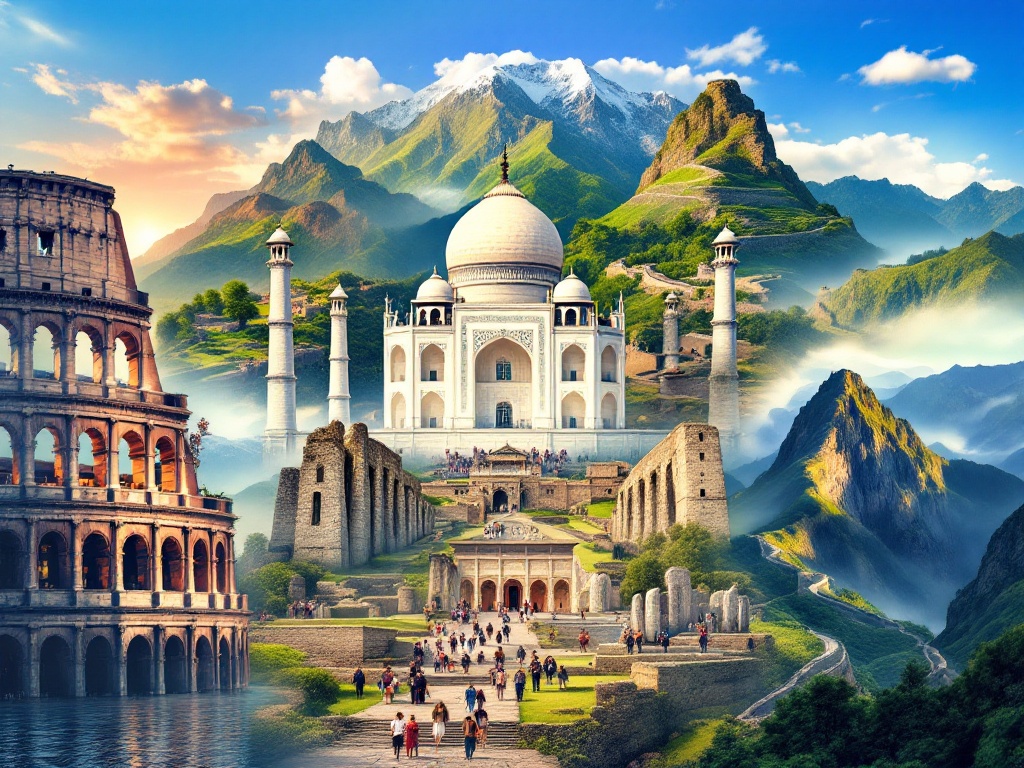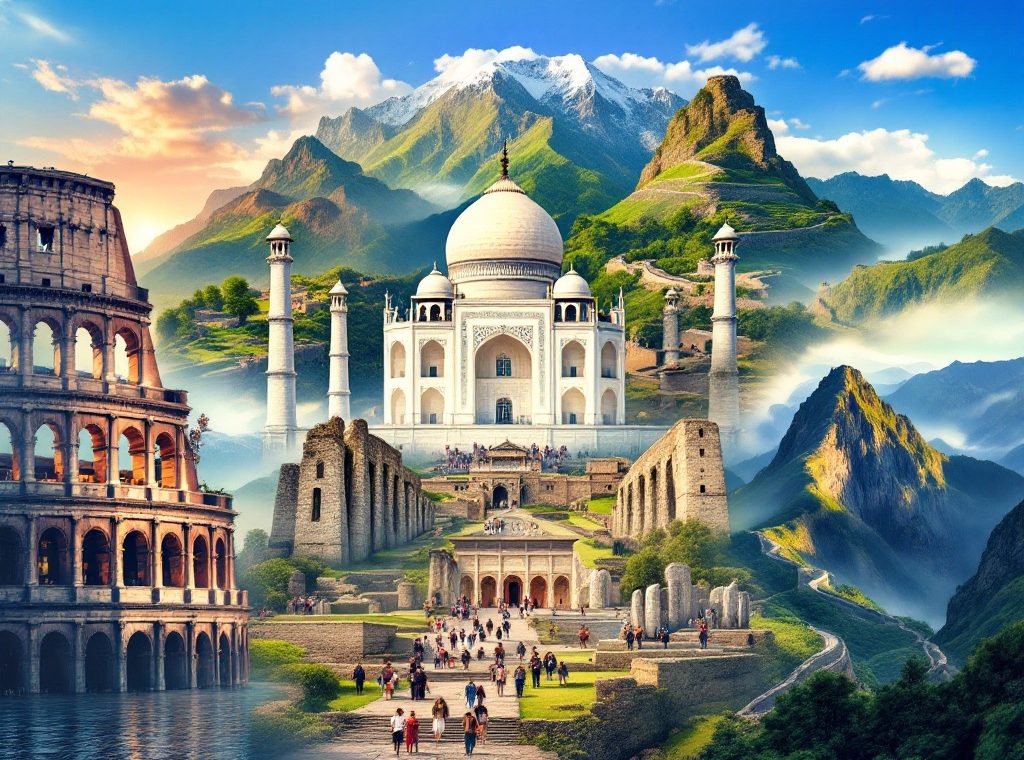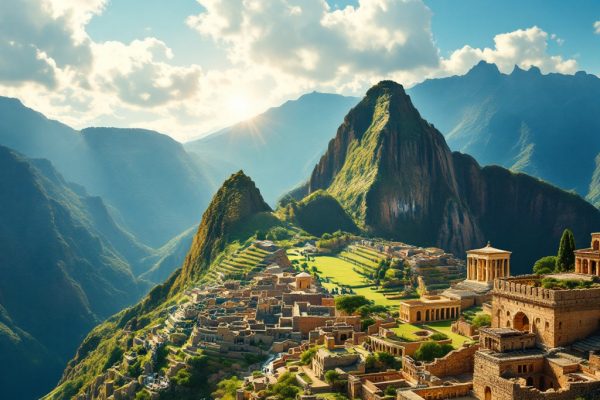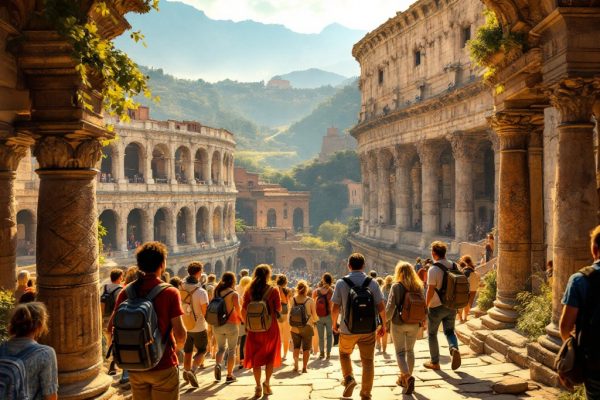The Most Popular Historical Places in the World
Journey through time and explore the world’s most captivating historical sites! From the gladiatorial grandeur of Rome’s Colosseum to the breathtaking beauty of India’s Taj Mahal, discover ancient wonders and architectural marvels. Uncover the secrets of Stonehenge, walk the Great Wall of China, and experience the Incan ingenuity of Machu Picchu. Explore these treasures and countless others. Start your adventure now!
Important information

- The Colosseum in Rome, built in 80 AD, hosted gladiatorial contests and public spectacles.
- The Pyramids of Giza, ancient Egyptian tombs, are one of the Seven Wonders of the Ancient World.
- China’s Great Wall, a UNESCO World Heritage site, stretches over 13,000 miles.
- Machu Picchu, high in the Peruvian Andes, showcases Incan architectural ingenuity.
- Sustainable tourism is crucial to balance economic benefits with the preservation of these important sites.
The Most Popular Historical Places in the World
Rome’s Colosseum, a stage for gladiatorial contests and public spectacles, remains incredibly popular. The Pyramids of Giza, ancient Egyptian tombs, inspire awe. China’s Great Wall stands as a testament to human engineering. India’s Taj Mahal embodies eternal love. Machu Picchu showcases Incan ingenuity. These sites draw millions annually.
- Rome’s Colosseum, a stage for gladiatorial contests and public spectacles.
- The Pyramids of Giza, ancient Egyptian tombs.
- China’s Great Wall, a testament to human engineering.
- India’s Taj Mahal, a symbol of eternal love.
- Machu Picchu, showcasing Incan ingenuity.
Other captivating destinations beckon adventurous travelers. Explore Angkor Wat in Cambodia, Petra in Jordan, or Spain’s Alhambra for a glimpse into fascinating ancient cultures. The Forbidden City, St. Peter’s Basilica, and the Palace of Versailles also captivate millions with their rich history and architecture. The Acropolis, home to the Parthenon, echoes the glory of ancient Greece. Stonehenge, possibly a ceremonial or burial site, dates back to 3000 BC.
- Angkor Wat in Cambodia.
- Petra in Jordan.
- Spain’s Alhambra.
- The Forbidden City.
- St. Peter’s Basilica.
- The Palace of Versailles.
- The Acropolis.
- Stonehenge.
Understanding Historical Sites and World Monuments
Historical sites and world monuments bridge the gap to our past, reflecting the unique cultures, architectural marvels, and societies of bygone eras. Iconic destinations like the Colosseum, the Pyramids of Giza, and the Great Wall draw millions of visitors annually, as do the Taj Mahal and Machu Picchu. These treasured landmarks offer fascinating glimpses into history, showcasing the remarkable achievements of past civilizations. Their preservation is essential for education and tourism alike.
These monuments illuminate human history, offering valuable lessons from past generations. The Colosseum, for instance, reveals the Romans’ architectural ingenuity, while the Great Wall demonstrates ancient Chinese defense strategies. These sites highlight the rich tapestry of human civilization and its remarkable diversity. Protecting these landmarks is crucial for the benefit of generations to come.
Visitor Statistics and Cultural Heritage Importance
Historic sites possess immense cultural value, attracting numerous visitors and significantly contributing to local economies through tourism. This revenue plays a vital role in preserving these irreplaceable treasures and promoting community growth.
However, implementing sustainable tourism practices is essential to strike a balance between economic benefits and the crucial protection of these sites.
These locations offer invaluable educational opportunities, inspiring a deeper understanding of our shared history. Preservation efforts ensure that future generations can also learn from and be inspired by these sites, safeguarding our heritage for years to come.
Iconic Architectural Landmarks Around the World
The Roman Colosseum, a marvel of engineering, hosted gladiatorial contests and stands as a testament to human ingenuity.
The Great Wall of China, a vast defensive structure, is another example of human ingenuity.
Stonehenge, a prehistoric monument in England, whispers of ancient rituals, its true purpose shrouded in mystery.
The Pyramids of Giza, awe-inspiring tombs for Egyptian pharaohs, are testaments to a powerful civilization.
India’s Taj Mahal, a breathtaking masterpiece of white marble, embodies eternal love.
The Great Wall of China: Engineering Mastery
The Great Wall of China, a marvel of ancient engineering, stretches over 13,000 miles. It stands as a testament to the ingenuity of the dynasties who constructed it over centuries to defend against invaders. Designated a UNESCO World Heritage site, it draws visitors worldwide for its rich history and breathtaking views. Sections like Badaling and Mutianyu offer convenient access for those eager to experience this iconic landmark.
The Colosseum in Rome, Italy: Ancient Roman Symbol
The Colosseum, completed in 80 AD, stands as a symbol of ancient Rome and a testament to its engineering prowess. This magnificent amphitheater hosted a wide array of events, from gladiatorial combats and public spectacles to dramatic mock sea battles. Its elliptical design and complex network of passageways efficiently accommodated massive crowds, showcasing Roman ingenuity. A visit to the Colosseum offers a captivating glimpse into the entertainment, social life, and culture of the Roman Empire.
Stonehenge, England: Prehistoric Monument
Stonehenge, a prehistoric marvel in England, dates back to around 3100 BC. Its purpose, shrouded in mystery, continues to fuel speculation. Was it a ceremonial site, a burial ground, or perhaps an astronomical observatory? Regardless of its original function, Stonehenge demonstrates the remarkable engineering prowess of prehistoric people. The transportation and erection of such massive stones remain an impressive feat even today. Its global significance is undeniable, as evidenced by its designation as a UNESCO World Heritage Site.
Pyramids of Giza, Egypt: Pharaohs’ Tombs
The Pyramids of Giza, constructed approximately 4,500 years ago as magnificent tombs for pharaohs, stand as a testament to the remarkable engineering skills of ancient Egypt. The site’s most prominent features are the three main pyramids: Khufu, Khafre, and Menkaure, each a wonder of architecture. Further enhancing the site’s allure is the Great Sphinx, a massive limestone statue. A designated UNESCO World Heritage Site, the Pyramids of Giza are one of the Seven Wonders of the Ancient World and an unforgettable destination.
Taj Mahal, India: Symbol of Eternal Love
The Taj Mahal, a UNESCO World Heritage Site located in Agra, India, is a breathtaking monument to eternal love. Built in the 17th century by Mughal Emperor Shah Jahan, this exquisite marble mausoleum serves as a tribute to his beloved wife, Mumtaz Mahal. The stunning architecture seamlessly blends Persian, Indian, and Islamic styles, featuring intricate inlay work and expansive surrounding gardens. Its beauty is particularly striking at sunrise and sunset.
Most-Visited Archaeological and Historic Sites
Angkor Wat, the world’s largest religious monument, draws millions of visitors annually to Cambodia.
Jordan’s Petra, the “Rose City,” is carved into sandstone cliffs, offering a unique blend of beauty and history.
High in Peru’s mountains, Machu Picchu showcases breathtaking Incan architecture, its intricate stonework a testament to their skill.
Easter Island, Chile, is famed for its enigmatic Moai statues, mysterious figures that beckon explorers to uncover the island’s rich cultural heritage.
Angkor Wat, Cambodia: Largest Religious Monument
Angkor Wat, dating back to the early 12th century, is the world’s largest religious monument. Originally built as a Hindu temple dedicated to Vishnu, it later became a Buddhist temple, mirroring Cambodia’s evolving religious landscape. Now a UNESCO World Heritage site, this magnificent structure exemplifies classic Khmer architecture, featuring intricate carvings and five iconic towers. Angkor Wat stands as a powerful testament to the Khmer Empire’s remarkable artistry and engineering skills.
Machu Picchu, Peru: Incan Architectural Ingenuity
Nestled high in the Andes Mountains lies the 15th-century Inca citadel of Machu Picchu, a true architectural marvel.
Commissioned by Emperor Pachacuti and rediscovered by Hiram Bingham in 1911, it quickly became a UNESCO World Heritage site.
The site showcases not only the Incas’ advanced engineering but also their innovative approach to agriculture.
Machu Picchu’s remarkable location and design further demonstrate their ingenuity in adapting to the challenging terrain.
This citadel stands as a testament to their skill and offers a captivating glimpse into their rich history and vibrant culture.
Petra, Jordan: The Rose City
Carved into the rose-hued sandstone cliffs of Jordan, Petra, a UNESCO World Heritage site, stands as a testament to the ingenuity of the Nabataeans, an ancient Arab people. This incredible city, their capital and a vital trade center, boasts stunning rock-cut architecture. Perhaps the most iconic example is Al-Khazneh, or The Treasury, a structure that showcases their remarkable skill. Beyond its beauty, Petra also possessed a sophisticated water system, far ahead of its time, further demonstrating their engineering prowess. This blend of natural beauty and historical significance makes Petra a truly wondrous and popular destination.
Easter Island, Chile: Home to Moai Statues
Easter Island, a Chilean territory, is renowned for its nearly 900 extant Moai statues. These imposing figures, carved from volcanic rock by the Rapa Nui people between the 13th and 16th centuries, represent deified ancestors. Researchers believe the islanders transported these massive sculptures using a sophisticated system of logs, ropes, and manpower, a testament to their ingenuity. The island’s unique history and the enigmatic Moai draw tourists and researchers alike, fascinated by the cultural practices surrounding these statues. Ongoing scholarly investigations continue to enhance Easter Island’s archaeological significance.
Significant Palaces and Fortresses
Granada, Spain, is home to the Alhambra, a magnificent palace and fortress complex dating back to the mid-13th century. It’s a stunning example of Nasrid dynasty architecture.
Across the border in France, the Palace of Versailles, once the primary royal residence, is renowned for its breathtaking Hall of Mirrors and sprawling gardens.
Alhambra, Granada, Spain: Mid-13th Century Marvel
The Alhambra, a palace and fortress complex nestled in Granada, Spain, embodies the legacy of the Nasrid dynasty. Dating back to the mid-13th century, this captivating Moorish marvel is Spain’s most popular historic destination. Visitors are enthralled by intricate arabesques, detailed stucco work, and lush gardens, all offering a breathtaking glimpse into Spain’s vibrant history.
Palace of Versailles, France: Royal Residence
The Palace of Versailles, a renowned former royal residence located in Versailles, France, attracts millions of visitors every year. Famous for its stunning Baroque architecture and impressive gardens, the palace became the seat of the French government in 1682 under King Louis XIV. It remained the center of French power until the start of the French Revolution in 1789.
Historic Capitals and Monuments in Urban Settings
Washington, D.C. showcases American history through monuments such as the Lincoln Memorial, Washington Monument, and Jefferson Memorial.
Beijing’s Forbidden City stands as a testament to centuries of imperial power. Its architecture reflects China’s rich dynastic past, exemplified by its traditional design.
Istanbul’s Hagia Sophia, once a Greek Orthodox cathedral and later a mosque, now serves as a museum, illustrating the city’s dynamic cultural and religious transformations.
Washington DC Monuments: Icons of American History
The Lincoln Memorial, a neoclassical temple, honors Abraham Lincoln, the 16th U.S. President, and symbolizes national unity, equality, and freedom. It’s indelibly linked to pivotal moments like Martin Luther King Jr.’s “I Have a Dream” speech.
The towering Washington Monument, an obelisk, commemorates the first U.S. President, George Washington.
The National World War II Memorial stands in solemn remembrance of American sacrifice during that conflict.
Distinctly different, the domed Jefferson Memorial celebrates Thomas Jefferson, the third U.S. President and author of the Declaration of Independence.
These iconic memorials embody American history and ideals, serving as powerful symbols for the nation.
Forbidden City, China: Imperial Palace
The Forbidden City, China’s imperial palace, served as home to emperors from the Ming and Qing dynasties for over 500 years (1420-1912). Situated in Beijing, this expansive 180-acre complex comprises 980 buildings, distinguishing it as the world’s largest collection of preserved ancient wooden structures. Declared a UNESCO World Heritage site in 1987, it attracts millions of visitors every year, solidifying its status as the world’s most visited monument. The magnificent architecture embodies traditional Chinese palatial style, emphasizing symmetry and symbolism, which were essential expressions of imperial power.
Hagia Sophia, Istanbul: Emblem of Evolution
Hagia Sophia stands as a testament to Istanbul’s vibrant history. Its stunning dome and intricate mosaics leave visitors awestruck, while the soaring minarets, a later addition, hint at its complex past. Originally a Byzantine cathedral, it served as the heart of the Eastern Orthodox Church for centuries. Following the Ottoman conquest, it was transformed into a mosque, reflecting the city’s shift to Islamic culture. Today, as a museum, Hagia Sophia showcases this layered history, where Byzantine and Ottoman elements intertwine, symbolizing Istanbul’s unique position at the crossroads of cultures. This blend represents not only its rich past but also its dynamic present.
Exploring Unique Historical Sites
- lalibela, ethiopia, is renowned for its incredible rock-hewn churches carved directly from the earth.
- newgrange, ireland, attracts visitors with its ancient passage tomb, a portal to the secrets of the past.
- cappadocia, turkey, offers a unique experience with its otherworldly fairy chimneys and caves.
- bagan, myanmar, presents a breathtaking vista of countless temples scattered across a vast plain.
Lalibela, Ethiopia: Rock-hewn Churches
Lalibela, Ethiopia, is renowned for its remarkable rock-cut churches. Carved from solid rock, these monolithic structures stand as a testament to the Zagwe dynasty’s engineering ingenuity and hold deep spiritual significance for Ethiopian Christians. Their unique architectural style has earned them UNESCO World Heritage status, signifying their global cultural importance.
Newgrange, Ireland: Ancient Passage Tomb
Dating back to 3200 BC, Newgrange is an ancient Irish tomb that predates both Stonehenge and the Egyptian pyramids. This large, circular mound, spanning a full acre, consists of earth and stones contained by a ring of massive kerbstones. A 62-foot passage leads into the heart of the mound, opening into a cross-shaped chamber with an ingeniously corbelled roof. While its exact purpose remains enigmatic, theories abound, suggesting it may have served as a burial site, a place of ritual, or even a solar observatory. The passage’s alignment with the winter solstice sunrise dramatically illuminates the chamber, demonstrating the builders’ advanced understanding of astronomy. Newgrange offers a fascinating glimpse into the beliefs, practices, and sophisticated skills of the Neolithic people who constructed it.
Cappadocia, Turkey: Fairy Chimneys and Caves
Cappadocia, Turkey, is famous for its whimsical fairy chimneys, rock formations sculpted by volcanic eruptions and erosion. These unique structures have served as homes and sanctuaries for centuries. The region also boasts Byzantine-era cave churches decorated with beautiful frescoes, reflecting a rich cultural heritage. Visitors worldwide are drawn to Cappadocia’s incredible geological formations and captivating history, making it a truly special destination.
Bagan, Myanmar: Sea of Temples
Bagan, Myanmar, is renowned for its thousands of Buddhist temples and pagodas. These magnificent structures showcase the country’s rich Buddhist heritage and remarkable architectural ingenuity. The site displays a variety of architectural styles, reflecting diverse historical influences and periods. Bagan stands as a testament to artistic brilliance.













